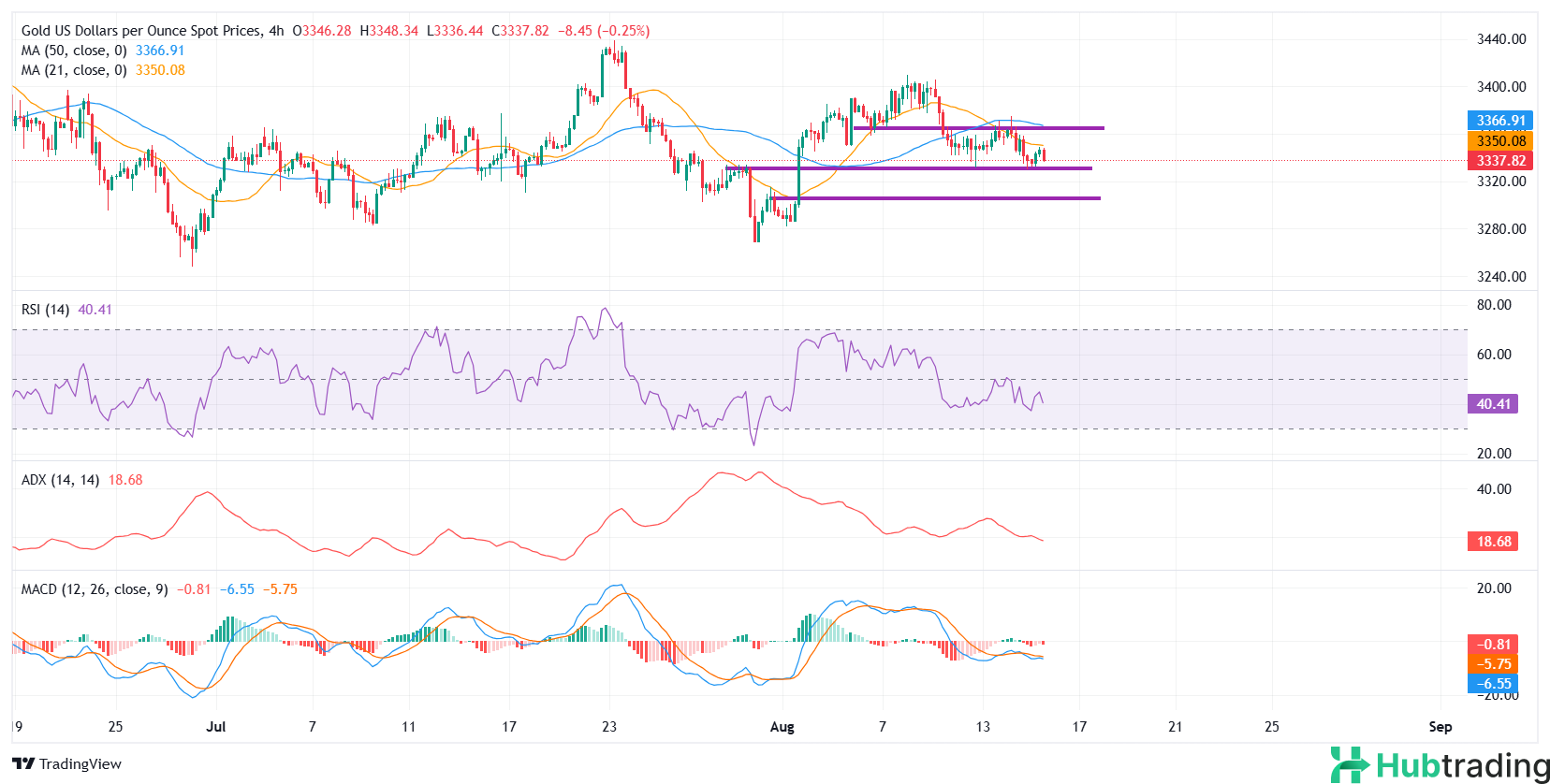-
Gold sees a modest rebound on Friday, aided by a softer US Dollar, but remains pinned near a two-week low as elevated US Treasury yields limit upside potential.
-
Investor focus turns to the upcoming Trump-Putin summit in Alaska and key US economic releases, including Retail Sales and the University of Michigan Consumer Sentiment Index.
-
Technical outlook remains bearish, with XAU/USD trading below the $3,350 level and momentum indicators signaling continued downside pressure.
Gold (XAU/USD) posts a modest recovery on Friday, buoyed by a softer US Dollar (USD), though the rebound remains limited as the metal hovers near a two-week low.
The precious metal is seeing cautious buying as markets await the high-stakes US-Russia summit in Alaska. However, rising US Treasury yields are keeping Gold's upside in check, following stronger-than-expected US Producer Price Index (PPI) data that has reignited inflation concerns and tempered expectations for aggressive rate cuts by the Federal Reserve (Fed). This has reduced demand for non-yielding assets like Gold.
As of writing, XAU/USD is trading around $3,343 in the European session, struggling to break above the $3,350 resistance barrier.
The modest bounce follows Thursday’s 0.50% decline to near $3,330, triggered by stronger US inflation data that boosted yields and the greenback, pressuring Gold.
Geopolitical developments remain in focus, with US President Donald Trump and Russian President Vladimir Putin set to meet in Anchorage to discuss a potential ceasefire in Ukraine. While safe-haven flows have yet to materialize, any deterioration in talks could quickly shift sentiment in Gold’s favor. Conversely, signs of diplomatic progress may further weigh on the metal.
Attention now turns to key US economic data due later on Friday, including Retail Sales, the NY Empire State Manufacturing Index, and the preliminary reading of the University of Michigan Consumer Sentiment Index for August. Strong results could support the US Dollar and pressure Gold further, while weaker figures may provide the metal with short-term support.
Market Movers: US Inflation Surges, Treasury Yields Rise, China’s Growth Disappoints
- The US Dollar Index (DXY) is trading slightly lower near 97.90 on Friday, after rebounding by nearly 0.40% in the previous session. The Greenback gained traction following hotter-than-expected US Producer Price Index (PPI) data, which signaled that rising import costs from tariffs are being passed on to consumers.
- US Treasury yields moved higher across the curve on Thursday, with the benchmark 10-year yield climbing around 5 basis points to 4.293%, while the 30-year yield held steady near 4.884%.
- Earlier in the week, risk sentiment had been buoyed by expectations of monetary easing, with markets fully pricing in a 25 basis-point rate cut by the Federal Reserve in September. However, accelerating wholesale inflation has shifted the narrative. July’s PPI surged 0.9% month-over-month — the fastest pace since June 2022 — lifting the annual rate to 3.3%. Core PPI, which excludes food and energy, also jumped 0.9% MoM, bringing the annual rate to 3.7%, with both figures exceeding forecasts.
- In response, traders have slightly reduced the probability of a rate cut in September to around 90%, according to the CME FedWatch Tool.
- St. Louis Federal Reserve President Alberto Musalem commented on Thursday that while the inflationary impact of tariffs may fade within 6 to 9 months, it could prove more persistent. He also noted that current data does not support a half-point rate cut, pointing to slightly higher labor market risks and slightly reduced inflation risks.
- Looking ahead, next week’s Jackson Hole Economic Symposium in Wyoming will be closely watched. Fed Chair Jerome Powell’s speech on August 22 is expected to offer fresh insights into the economic outlook and future policy direction, especially amid lingering inflationary pressures and shifting rate expectations.
- In Asia, China’s economic data showed signs of cooling. July Industrial Production grew by 5.7% year-over-year, down from 6.8% in June and below the forecasted 5.9%. Retail Sales also missed expectations, rising 3.7% YoY versus the expected 4.6%, highlighting weakening domestic demand in the world’s top Gold consumer and dampening the medium-term outlook for physical bullion demand.
- Attention now turns to a key slate of US data due later Friday. Retail Sales for July are expected to rise by 0.5% after June’s 0.6% increase. Core Retail Sales, excluding autos, are projected to climb 0.3%. Industrial Production is anticipated to be flat after a 0.3% increase in June. Meanwhile, the preliminary reading of the University of Michigan’s Consumer Sentiment Index for August is expected to edge up to 62 from 61.7, with the expectations component likely dipping to 56.5 from 57.7, indicating lingering consumer caution.
Technical Analysis: Gold (XAU/USD) Struggles Below $3,350 with Weak Bullish Momentum

Gold (XAU/USD) remains under pressure on the 4-hour chart, currently trading near $3,340 and unable to gain strong upside traction. The metal is hovering just below the 21-period Simple Moving Average (SMA), which sits near the $3,350 mark, acting as immediate resistance.
On the downside, $3,330 serves as nearby support, forming the lower bound of the recent consolidation range. A clear break below this level could accelerate losses toward the psychological $3,300 handle.
Resistance is first seen in the $3,350–$3,355 region, followed by a more significant hurdle at $3,370, where the 50-period SMA at $3,367 intersects with a recent swing high. A sustained break above $3,370 could pave the way for a test of the $3,400 psychological level.
Momentum indicators reflect a bearish bias. The Relative Strength Index (RSI) is hovering near 40, suggesting weak downward momentum. The Average Directional Index (ADX) sits at 18.7, indicating a lack of strong trend strength. Meanwhile, the MACD remains in negative territory, with the signal line above the MACD line and subdued red histogram bars — all pointing to mild downside pressure.
In summary, unless Gold can reclaim and hold above the $3,350–$3,355 resistance zone, the path of least resistance remains tilted to the downside, with potential targets at $3,325 and $3,300.





